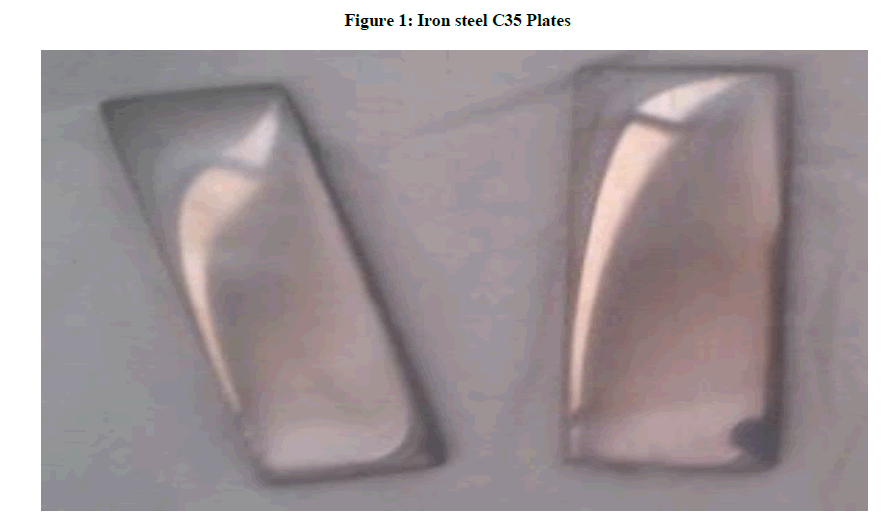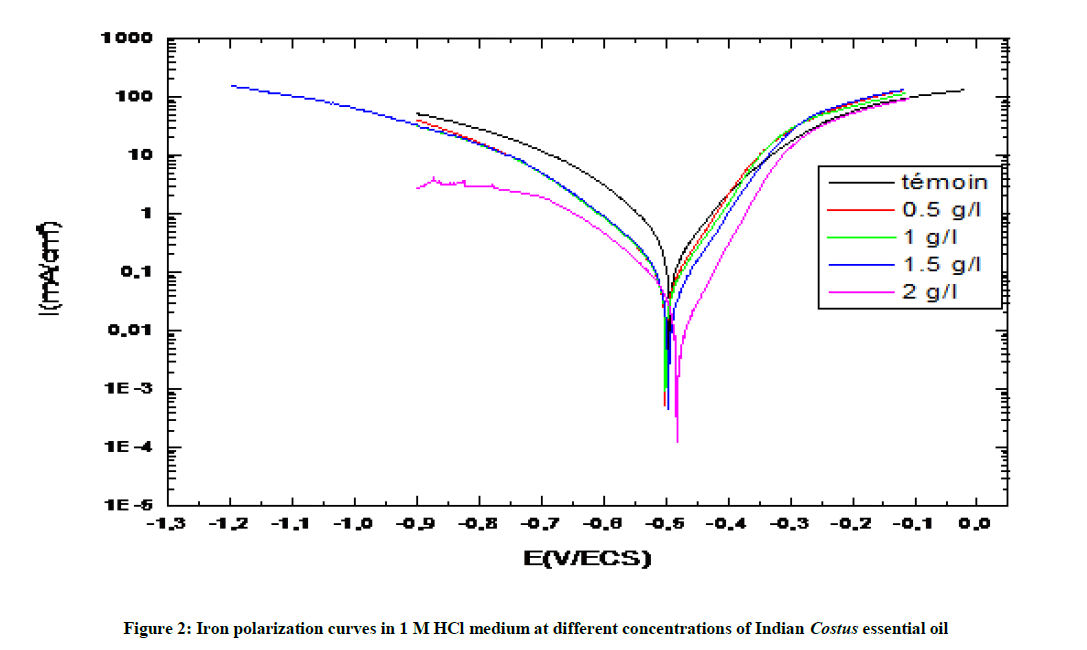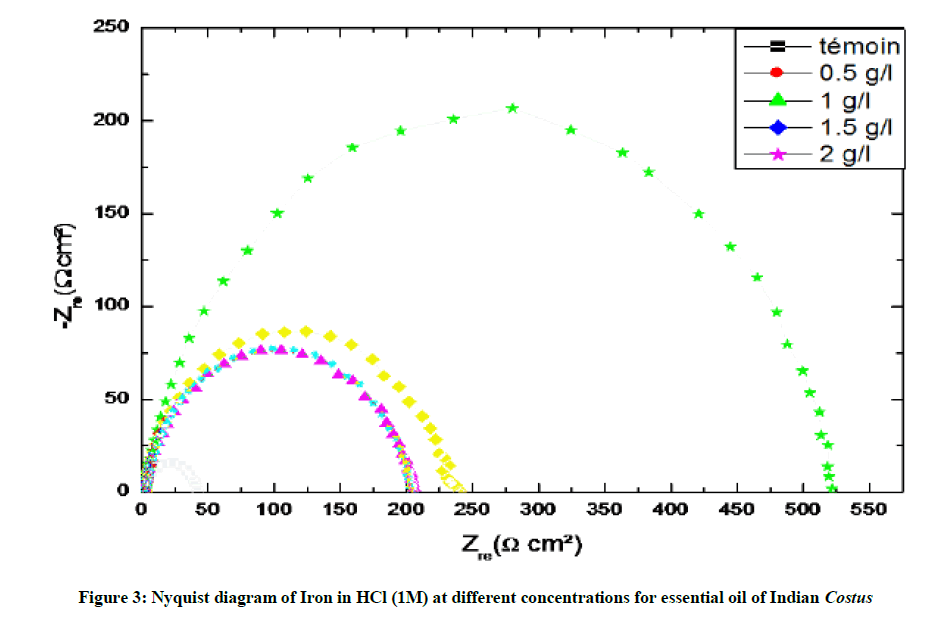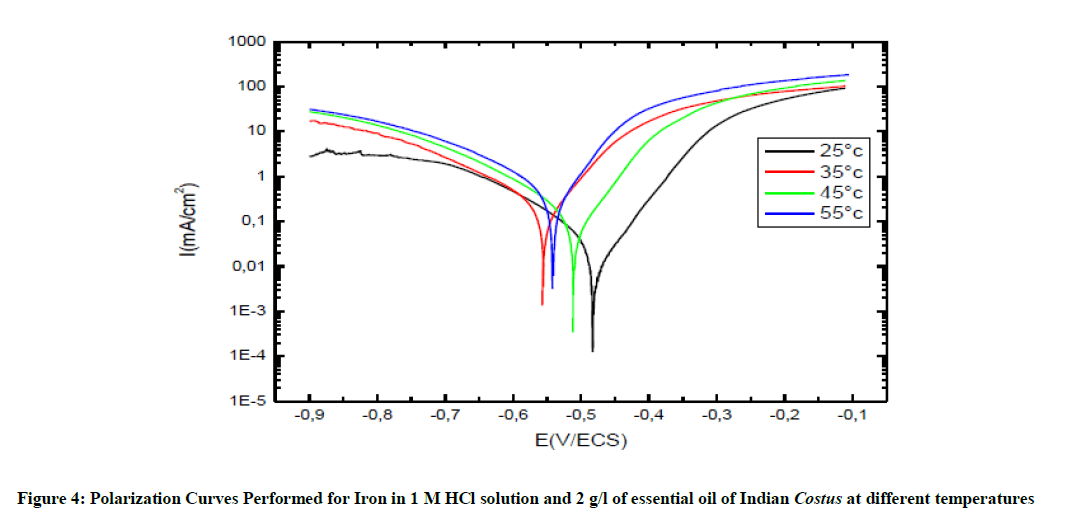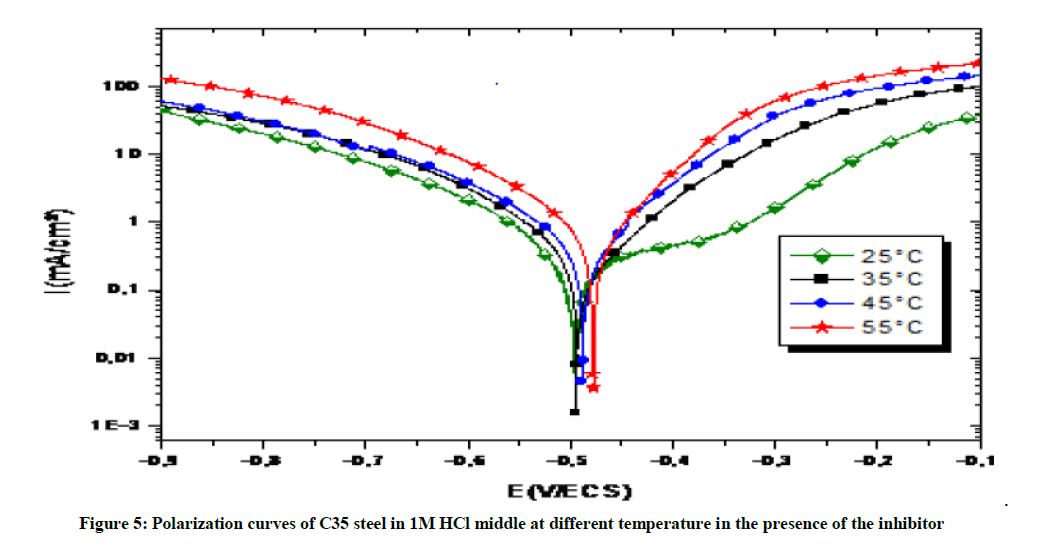Research Article - Der Pharma Chemica ( 2018) Volume 10, Issue 7
Study of the Inhibitory Effect of Essential Oils of Indian Costus Against Corrosion of Steel of Iron C35 in a Medium Acid
Alami Y1*, Mouissa M1, Rhaiem N1, O. Elbekkali O1, Gala M2, Tazi S3, Ebn Touhami M2, Chaouche A1 and Ouhssine M1
1Faculty of Sciences, Laboratory of Agrophysiology, Biotechnology, Environment and Quality, Ibn Tofail University, B.P.133, 14000, Kenitra, Morocco
2Faculty of Sciences, Laboratory of Materials Engineering, Modeling and Application, Ibn Tofail University, BP 133, Kenitra 14,000, Morocco
3Laboratory of Materials and Interfacial Systems, ERESI Team, Faculty of Sciences of Tetouan, Morocco
- *Corresponding Author:
- Alami Y
Faculty of Sciences
Laboratory of Agrophysiology
Biotechnology Environment and Quality Ibn Tofail University
B.P.133, 14000, Kenitra, Morocco
Abstract
Essential oils extracted of aromatic plants are studied in various fields. To expand their application, a study of their inhibitory effects against corrosion of metals is performed, to replace toxic chemical products used. The used tools in this study is the extracted essential oil roots of the Indian Costus plant by hydrodistillation and the steel metal of iron C35 placed in an acidic medium. The yield in essential oil is 0.15%. The results obtained show the beneficial effect of these oils on the metal, if the concentration of essential oil is higher (2 g/l) more than the corrosion rate is low (94%). Similarly, if the concentration in inhibitor increases more than capacity Double layer Cdc decreases (38.42 uF/cm2 for a concentration of 2 g/l). In the same way essential oil of Indian Costus is a good corrosion inhibitor in the temperature range from 25°C to 55°C.
Keywords
Essential oils, Corrosion, Inhibitor, Hydrodistilation, Iron steel.
Introduction
Corrosion is an oxidation of a metal which drives to the formation of an oxide. It affects all metals [1]. It results from the physic-chemical interactions between the material and its environment causes changes in the properties of the metal often accompanied by a functional deterioration of the last (alteration of its mechanical properties, electric, etc.) in the presence of a liquid phase, as an electrochemical process. She is harmful when the oxide has a lower density than the metal and that becomes so expansive and leads to the ruin of the metal support. It's a constant and ongoing problem, often difficult to eliminate completely. Corrosion affects industrial equipment [2] and can engender the loss billions of dollars every year [3]. The use of inhibitors for prevent the dissolution process metals rest an inevitable application and very widespread. An inhibitor works as adsorbent on the surface of a metal, and therefore it reduces the speed of corrosion by the increase of kinetics of the anodic or cathodic reaction, then a drop in the broadcast speed reagents on the surface of metals and a decrease electrical resistance to the metal surface.
Many works were realized on nitrogen organic compounds and they showed than these inhibitors have Inhibitory efficacy important on different materials and in different corrosive environments [4-8]. However, these compounds present toxic effects on the body and poisoning of the environment [9]. In the research framework less aggressive alternatives and following the studies that were done on the inhibition corrosion by extracts essential oils of Eugenio, we tested the effect anti corrosive extracted essential oils of the Indian Costus plant against the metal of iron steel C35 in an acid middle.
Materials and Methods
For study, the behaviour of a material in the corrosive solution in the presence and absence of the inhibitors, two evaluation methods are to be used namely:
- The curves route of stationary polarization;
- Measurement of electrochemical impedance spectroscopy.
The metal used
We used in this study of samples Iron steel C35 (Figure 1) whose composition is illustrated in the following Table 1:
| Other Elements than Iron Fer | Carbon | Silicon | Magnésium | Soufre | Chrome | Titane | Nickel | Cobalt | Copper |
|---|---|---|---|---|---|---|---|---|---|
| Content wt % | 0.37 | 0.23 | 0.68 | 0.016 | 0.077 | 0.011 | 0.059 | 0.009 | 0.16 |
Table 1: Chemical composition of iron steel C35
The samples steel C35 are prepared before each immersion, by polishing in abrasive paper of grain 400 until 2000, then they are degreased with acetone, and they are rinsed with distilled water and dried in hot air. The corrosive solution used is a hydrochloric acid solution at 1 M.
Extraction of the essential oil
The essential oil is recovered of the Indian Costus plant by hydro distillation using the apparatus Clenvenger. The plant taken away in the laboratory is shelled of it’s leaves these are dried to the shadow and the free air during 10 days. After that they are put in a ball with a quantity 200 g of the Indian Costus plant with 1 l of distilled water. Everything is worn heat on a hotplate during 4 h. Recovery of essential oils is made by refrigerant cooling. The extract obtained is dissolved in an ethanol solvent and put in a cry tube then stored in the dark in the refrigerator at 4°C.
Electrochemical Techniques and Transient Techniques
polarization curves
The use mounting is composed three electrodes (platinum counter-electrode, a reference electrode saturated calomel (ESC) and a working electrode) added a potentiostat PGZ100 of VOLTALAB type and piloted by a computer and "Volta Master 4" software. The electrode is maintained 30 min immersion to the potential of corrosion. Electrochemical measurements are realized using this apparatus. Before starting the tracing of the curves (cathodic and anodic), the working electrode is maintained to its potential abandonment during an hour. The intensity of the current is measured between the working electrode and the platinum counter-electrode. This tracing of the curves (intensity-potential) allows the determination of the corrosion potential (Ecorr), the corrosion current density (Icorr), the cathodic (bc) and anodic (ba) salopes of Tafel and by consequent effectiveness of the inhibitor by measuring the corrosion current of the metal in a corrosive solution with inhibitor Icorr (inh) and without inhibitor Icorr.
Electrochemical impedance spectroscopy
Electrochemical impedance measurements are performed after one hour of immersion in 1 M hydrochloric acid medium at a temperature of 25°C. The operating conditions used of the electrochemical system are the same as those of the polarization curves. The measures determined abandonment potential are automatically treated by the software VoltaMaster4 from the impedance diagrams made at the corrosion potential (Ecorr), we access at charge transfer resistors (Rt), and the double layer capacity, and so at inhibition rate.

Results and Discussion
Effect of concentration
Polarization Curves
Cathodic and anodic curves of Iron polarization in (1 M) HCl middle with and without addition essential oils of Indian Costus at different concentrations are presented in Figure 2.
The examination of Figure 2 shows that anodic and cathodic reactions are affected by the addition of the biological inhibitor to Iron in 1 M HCl middle solution, which induces the decrease of anodic partial current corresponding to the dissolution of the metal according the reaction: Fe ↔ Fe2+ + 2e-. Also the decrease in cathodic current corresponding to the reduction of the proton according to the opposite reaction: 2H+ + 2e- ↔ H2. As a result, the corrosion potential rests almost stable, These results explain that the essential oil has an anticorrosive effect at a time on the level of the anodic and cathodic electrode.
The corrosion inhibitory effectiveness E (%) is defined by the following equation:
 (Eq.1)
(Eq.1)
Icorr and I°corr are respectively values of corrosion current density with and without determined inhibitor by extrapolating the cathodic lines of Tafel corrosion potential. The densities Icorr and I°corr are determined by extrapolation of the cathodic and anodic lines are determined by extrapolation of the cathodic and anodic lines of Tafel for corrosion potential [10,11].
The results grouped in Table 2 show that the current density of corrosion (Icorr) decreases as and measure that the concentration of the essential oil increases, it has passed from 0.15 mA/cm2 at a concentration of 0.5 g/l to 0.05 mA/cm2 at a concentration of 2 g/l. The same remark for the corrosion potential (Ecorr), it has passed from -498.4 mv at 0.5 g/l to -481.7 mv at 2 g/l. while inhibition efficiency E (%) increased in passing of 82% for the concentration from 0.5 g/l to a maximum value from 94% at 2 g/l.
| Concentration in E.O. (g/l) | Ecor (mv) | Icor (mA /cm2) | Bc (mv) | Ba (mv) | E (%) |
|---|---|---|---|---|---|
| Témoin | -498 | 0.84 | -105 | 99 | - |
| 0.5 g/l | -498.4 | 0.15 | -129.3 | 66.4 | 82 |
| 1 g/l | -497.9 | 0.13 | -126.1 | 65.2 | 84 |
| 1.5 g/l | -496.7 | 0.1 | -125.3 | 64.7 | 88 |
| 2 g/l | -481.7 | 0.05 | -123.2 | 54.1 | 94 |
Table 2: Iron Electrochemical Parameters at Different Concentrations Essential oil of Indian Costus in 1M HCl and the corresponding inhibition efficiency
Electrochemical impedance spectroscopy
The Nyquist diagram, Iron immersed in 1 M HCl with absence and in the presence of essential oil at different concentrations during 30 min of immersion, is illustrated in figure.
From Figure 3, the diameters of capacitive half-loops increase with the increasing concentration of the inhibitor. These graphs are consisting of a single capacitive loop. This type of diagram indicates that the corrosion reaction is controlled by process of charges transfer on a solid electrode of heterogeneous and irregular surface.
The values obtained from the electrochemical parameters and inhibitory efficacy ERt (%) for the different concentrations of the essential oil of Costus are grouped in Table 3. The inhibitory efficacy is calculated from the values of the charge transfer resistance Rt according to the following relationship:
| Concentration in E.O (g/l) | Rt(ohm.cm2) | Cdc(uF/cm2) | E% |
|---|---|---|---|
| Témoin | 40 | 294 | - |
| 0.5 g/l | 204 | 62.4 | 80 |
| 1 g/l | 205.6 | 48.91 | 80.5 |
| 1.5 g/l | 242 | 41.5 | 83.5 |
| 2 g/l | 591.9 | 38.42 | 93 |
E.O: Essential Oil
Table 3: Electrochemical Parameters and Inhibitory Efficacy of iron corrosion in HCl (1 M) with and without addition essential oil of Indian Costus
 (Eq.2)
(Eq.2)
Rt and R0t are respectively the values of charge transfer resistance with and without addition of inhibitor. The charge transfer resistance is calculated from the diameter of the capacitive loop. The values of the capacity of the double layer Cdl are determined from the following relation:
 (Eq.3)
(Eq.3)
Cdl est la capacité de la double couche en (μF.cm-2), is the maximum frequency in (Hz) and Rt is the charge transfer resistor (kΩ.cm2).
According the illustrated results in Table 3, it appears that more concentration in inhibitor increases more that the capacity of the double layer Cdc decreases, in passing 62.4 uF/cm2 for a concentration 0.5 g/l of the essential oil at 38.42 uF/cm2 for a concentration of 2 g/l of inhibitor while the charge transfer resistance increases from 204 Ohm.cm2 for 0.5 g/l to 591.9 Ohm.cm2 for 2 g/l of inhibitor. The decrease in the value of Cdc can be attributed to inhibitor molecules adsorption on the iron surface forming a protective layer. These results confirm and complete those obtained by the polarization method [12,13].
Temperature effect
Polarization study
The temperature influence on inhibitory efficacy of essential oil has been studied. The polarization curves obtained in 1 M HCl with and without the addition of the biological inhibitor at 2 g/l in the temperature range from 25°C to 55°C, are represented in the following figure.
From Figures 4 and 5, it appears that current densities increase with temperature increasing from 25°C to 55°C and the corrosion potential moves to more negative values
Values of the corrosion current densities (Icorr), the corrosion potentials of Iron (Ecorr) and of Inhibitory efficacy ERT (%) according to of the temperature are illustrated in the following table.
The temperature influence on inhibition efficiency of essential oil for Indian Costus plant was also studied by potentiometer. The polarization curves obtained in 1 M HCl with and without the addition of 2 g/l of essential oil of Indian Costus while a 15 min of immersion in the temperature range (25-55°C) are shown in Figure 4. The characteristic parameters of these curves are presented in Table 4.
| T (°C) | Ecorr (mV/ESC) | I (μA/cm2) | ba(mV/dec) | bc (mV/dec) | E% | |
|---|---|---|---|---|---|---|
| HCl 1 M | 25 | 498 | 0.84 | 92 | 203 | - |
| 35 | 491 | 1.6 | 178 | 200 | - | |
| 45 | 475 | 2.42 | 165 | 191 | - | |
| 55 | 465 | 3.1 | 151 | 170 | - | |
| HCl 1 M + 2 g/l of essential oil of Indien Costus | 25 | 481.7 | 0.05 | 123.2 | 54.1 | 94 |
| 35 | 553.7 | 0.26 | 143.1 | 57.1 | 84 | |
| 45 | 510 | 0.29 | 160.2 | 50 | 88 | |
| 55 | 541.1 | 0.55 | 145.6 | 50 | 82 |
Table 4: Inhibitory efficiencies and electrochemical parameters of steel in 1 M HCl in the absence and in the presence of the essential oil inhibitor (2 g/l) at different temperatures
According to Figure 4, we note that in the absence of the inhibitor, the corrosion potential Ecorr of witness moves to the less negative anodic values with the temperature increasing and in the presence of the inhibitor, the potential Ecorr moves in opposite directions (towards the cathodic values). The analysis of the Table 4 shows that, Current densities increase with temperature increasing from 25°C to 55°C, the curves in the cathodic part are parallel, indicating that the reduction of ions H+ on the surface of C35 steel is done according to the same pure activation mechanism in all the temperature range 1.
In the absence of the inhibitor, the temperature increasing causes a rapid increasing in Icorr values in all the temperature range studied, confirming a growing metallic dissolution with the increase of the temperature. The Increase in current corrosion with the temperature in the presence of the inhibitor is widely lower only in the witness. Inhibitory efficacy (E%) essential oil is diminished according to the increase of temperature, this decrease can be explained by the desorption of Indian Costus on the steel surface. We can say that lowering of inhibitory efficacy rests satisfactory in all the domain studied, which confirms that the essential oil of Indian Costus inhibits the temperature steel at 25°C.
Conclusion
The results obtained show that the essential oil of Indian Costus has an inhibitory effect opposite corrosion of steel 35 (Iron) in the acid medium, but it depends on the used concentration. This translates by a decrease in the density of the corrosion current leading to an inhibitory efficacy (E). In addition, an increase in the concentration of the inhibitor leads to a decrease in density of the anodic and cathodic current and also a light variation of the corrosion potential towards less negative values which confirms that this type of inhibitor is mixed with anodic predominance. This study also showed that the temperature is a likely factor to modify at a time the behaviour of steel in a corrosive environment and the nature of the metal interaction/inhibitor. The increase in temperature (50°C) has an important incident on the formation of the inhibiting film, indeed an elevation of temperature (55°C) favours the desorption of an inhibitor which results in the rapid dissolution of the organic compounds and causes a weakening of the resistance to corrosion of steel 35, consequently the inhibitory efficacy decreases.
References
- A. Fabas, D. Monceau, C. Josse, P. Lamesle, A. Rouaix-Vande Put, Corr. Sci., 2016, 107, 204-210.
- F. Farahbod, Engg. Failure Anal., 2012, 22, 38-49.
- M.H. Hussin, M.J. Kassim, Mater. Chem. Phys., 2011, 125, 461.
- A. Elouafi, B. Hammouti, H. Oudda, S. Kertit, R. Touzani, A. Ramdani, Anti Corros. Meth. Mater., 2002, 49, 199.
- A. Dafali, B. Hammouti, R. Touzani, S. Kertit, A. Ramdani, K. Elkacemi, Anti Corros. Meth. Mater., 2002, 49, 96.
- R. Salghi, L. Bazzi, B. Hammouti, E. Zine, S. Kertit, S. El Issami, E. Ait Eddi, Bull. Electrochem., 2001, 17, 429.
- M. Tourabi, K. Nohair, A. Nyassi, B. Hammouti, A. Chetouani, F. Bentiss, Mor. J. Chem., 2013, 1, 33.
- N.O. Eddy, E.E. Ebenso, Pure Appl. Chem., 2008, 2, 46.
- E. Chaieb, A. Bouyanzer, B. Hammouti, M. Benkaddour, Appl. Surf. Sci., 2005, 246, 199.
- Y. Massiani, J.P. Crousier, J. Crousier, J. Galea, R. Romanetti, Electrchim. Acta., 1984, 29(12), 1679-1683.
- I.B. Obot, N.O. Obi-Egbedi, Curr. Appl. Phys., 2011, 11, 382.
- P. Dupin, A. De Savignac, A. Lattes, Mat. Chem., 1981, 6(6), 443-453.
- S. Tazi, I. Raissouni, F. Chaoukat, D. Bouchta, A. Dahdouh, R. Elkhamlichi, H. Douhri, Sci., 2016, 7(5), 1642-1652.

